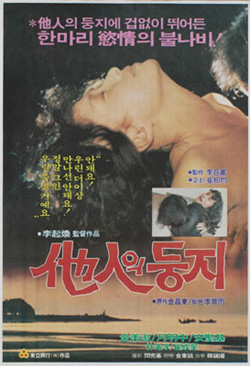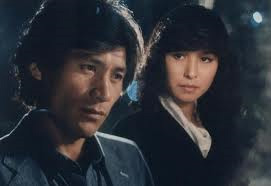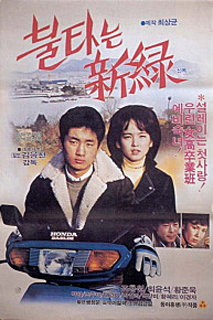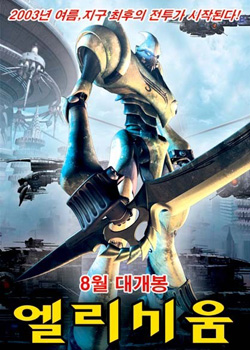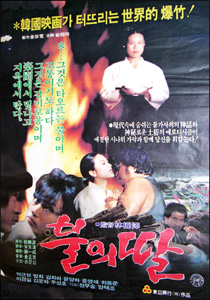The Sun Rises at Night– Directed by Lee Gyu-woong. Starring Yang Jeong-hwa <as Yeong-rim>, Kim Jin <as Woo-yeong> and Nam Goong-won <as Hyeong-jae>. Running Time: 93 minutes. Originally released on August 9, 1974.
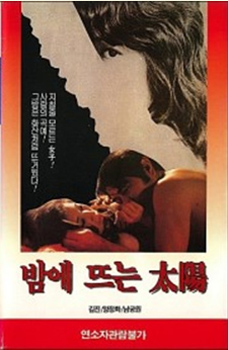 Full of confidence and courage, a recent highschool graduate arrives in Seoul from the countryside with nothing more than her transcripts and a letter of acceptance to a prestigious university. Having nowhere to go does not bother her as she approaches an art professor and places herself in his hands. While she does take the first step in asking him to buy her dinner, which she wolves down greedily, the teacher, Hyeong-jae, makes arrangements to set her up with her own apartment. Of course, there is a catch. Yeong-rim is asked to model for him twice a week. Yeong-rim sees no danger in this and thinks nothing of the fact that the much older man lets himself into her apartment anytime he wants. She is so trusting and comfortable with him that she has no problem with walking around in front of him wrapped in nothing more than a towel and, judging from the portraits we see on display, she has posed in the nude for him. It is clear from her words, actions and body language, she views Hyeong-jae as a daughter views a father. Hyeong-jae’s motives and feelings, however, are extremely questionable…
Full of confidence and courage, a recent highschool graduate arrives in Seoul from the countryside with nothing more than her transcripts and a letter of acceptance to a prestigious university. Having nowhere to go does not bother her as she approaches an art professor and places herself in his hands. While she does take the first step in asking him to buy her dinner, which she wolves down greedily, the teacher, Hyeong-jae, makes arrangements to set her up with her own apartment. Of course, there is a catch. Yeong-rim is asked to model for him twice a week. Yeong-rim sees no danger in this and thinks nothing of the fact that the much older man lets himself into her apartment anytime he wants. She is so trusting and comfortable with him that she has no problem with walking around in front of him wrapped in nothing more than a towel and, judging from the portraits we see on display, she has posed in the nude for him. It is clear from her words, actions and body language, she views Hyeong-jae as a daughter views a father. Hyeong-jae’s motives and feelings, however, are extremely questionable…
Aside for her apartment arrangement, Yeong-rim has a very normal life as university student. She has become close to her classmate and excels in her studies. She frequents coffee shops and does volunteer work on the side. In the course of these events, she even has time for her friends to set her up on a date with Woo-yeong. After a rough start, the two eventually hit it off and become an official couple. The realization that his project has a boyfriend closer to Yeong-rim’s age– otherwise known as half Hyeong-jae’s age– does not sit well with him. He does his best to sabotage the budding relationship by forcing Yeong-rim to miss her first all-day date with Woo-yeong, but at the first opportunity, she makes it up to him.
Witnessing the young couple walking down the street arm-in-arm drives Hyeong-jae to drink and brood. As his mood becomes darker and more self-absorbed, he convinces himself that he has fallen in love with Yeong-rim. He once again lets himself into her apartment, this time startling her because of the his hardened demeanor and the lateness of the hour. She has good reason to fear him as he proceeds to attack her while confessing his ‘love.’ Despite her struggles, Yeong-rim is no match for the heavy-set Hyeong-jae and she is soon overpowered and raped. It is a crushing blow to the formerly carefree young woman and she wanders around for hours in the dead of a rainy night. She is filled with self-destructive thoughts and feels that she has become ‘filled with darkness’ and is now a ‘fallen’ woman.
Collapsing on the street, Yeong-rim is taken in by a kindly prostitute. Even though she does not tell her rescuer what has recently transpired, the other woman guesses and gives some sage advice which gives Yeong-rim the hope she needs to go on with her life and to dismiss the other thoughts she had on punishing herself, either by suicide or by turning to prositution as she is ‘runined’ for a decent marriage. She attempts to go through her daily routines are difficult however, as she has told no one what has happened. Her former light-heartedness is gone and her friends are finding her hard to be around. Her boyfriend too is very confused. Yeong-rim clearly needs him and she does her best to reach out to him in a limited fashion, but she quickly pulls away from him when he tries to become closer and shudders or jumps whenever there he touches her. His solution is to introduce her to his family and propose marriage.
Yeong-rim goes along with his plans with reservations. She still feels she is no longer worthy of the love of such an innocent and sincere young man. Also, making matters worse, the art teacher is looking for her and asks her friends to arrange a meeting between himself and Yeong-rim. Is there anyway to make that situation more uncomfortable for the poor girl? Yes! The rapist brings along his wife who wants to confront Yeong-rim about what seems to be an affair between the two. Oddly, Hyeong-jae leaves the two women to talk alone he sits at a different table and smugly smokes. He strongly dislikes his wife and, even though they live together, he snidely mentions that he has had nothing to do with her for the past ten years. He seems to believe that his wife will leave him after talking with Yeong-rim and he is just smug enough where he may believe that the young college student will become his now that, traditionally, she has limited options and if his wife is out of the way. He may even feel that Yeong-rim will not relate the actual events out of shame. However, he is mistaken. Yeong-rim opens up to Hyeong-jae’s wife and relates events exactly as they happened and the older woman is sympathetic. The two women actually wind up meeting again when Yeong-rim and Woo-yeong meet Woo-yeong’s mother at a coffee shop and we see that the mother and Hyeong-jae’s wife are close friends. However, out of pity and respect for Yeong-rim, her secret is kept.
The strain of keeping such a painful secret gnaws at Yeong-rim until she decides to reveal to her boyfriend what happened. Taking him to a hotel room, she tells him her situation and why she has changed so much in recent weeks. Woo-yeong’s reaction is despicable, yet not unexpected if one has watched many old Korean movies. The young man who seconds ago was smitten with Yeong-rim, now finds her disgusting and strikes her across the face, knocking her to the floor before storming out of the hotel. To her credit, Yeong-rim does not immediately collapse in grief over losing him. Instead, she summons her strength and trudges back to her apartment….
…Only to find Hyeong-jae waiting in the dark for her! He now claims her as his property and proceeds to attack her again. Yeong-rim cries out this time and struggles more vigourously than before, but it is to no avail…or is it? Their struggles have brought them to the living room. Yeong-rim is thrown onto the sofa but, just out of reach, there is a large kitchen knife she was using to peal apples. Things happen fast and the next thing Yeong-rim knows, Hyeong-jae is lying dead with the knife plunged deep into his back.
Yeong-rim is carted off to prison and a trial and even she cannot say for sure whether she murdered her rapist in self-defense. There are other suspects after all including the possibility that Woo-yeong had a change of heart and followed her back home and witness what happened. Or was there someone else who decided to help Yeong-rim and who may reveal him/herself in time to save her from a life of imprisonment?
The Sun Rises At Night is interesting as it challenges the notion frequently seen in older Korean movies where a woman who has lost her innocence is no longer fit for marriage. I can’t tell you how many movies I have seen where someone is raped and then is either forced to live with her attacker as husband and wife or else falls in love with the man who raped her. And it is not confined to older movies as the otherwise excellent Oasis pulled out that same old trope. Here, Yeong-rim makes a conscious choice not to follow the paths of her cinematic predecesors and she elects instead to go on with her life. Her confession to Woo-yeong is not an admission of guilt, but rather a way to both unburden herself of the tragedy she experienced and as an explanation as to why she does not want him to touch her even though she claims to love him. Her resignation to his immediate and violent reaction is a sign that she was not expecting him to understand her problems and lend his support in her recovery. Although drained at that point, we know from her behaviour previously that Yeong-rim will not give up even though the man professing to love her seems to have abandoned her without a second thought.
The story telling technique, while not uncommon, was handled well. The story starts in the present, switches into an extended flashback that comprises most of the movie, and then returns to the present. The start of the film is actually when Yeong-rim and Hyeong-jae’s wife meet and former tells the entire story which we get to watch unfold. This explains the confusion I felt at the opening five or ten minutes where characters just come in and out without introduction. It felt as if I had walked in on the middle of the film and, because there are no intros, I think that is exactly what happened. The movie feels as if it were filmed with time flowing in the standard, lateral motion but then the director decided to cut the story and insert the beginning portion in the middle for the flashback. The feeling of not knowing what is going on or who the characters are quickly passes as Yeong-rim relates the events up to that point and I appreciated the director trying something a little more creative like that.
The print of the movie I watched on Hana TV was in rather poor condition. The lighting especially was a problem and even viewing the bright, outdoor scenes is like watching a movie wearing sunglasses. There is also a problem with how the reels of the film flow together. At three or four times during the film, the reels changed and we are treated to watching upside-down numbers count backwards from four. And at one point in the movie, visuals cut out altogether and we are left with looking at a white screen while various characters recite their lines. Fortunately, the effect does not last long.
Just a quick note– the video box image depicted at the top of this review manages to get the name of the film wrong in Korean. It is written 밤에 뜨는 태양. However, the name of the title of the film is actually 밤에도 뜨는 태양. Oh well, no one is perfect…
This past weekend, I took a rare trip up to Seoul to visit a friend. While there, we decided to see a movie and, since neither of us had seen The Berlin File, that is what we opted for. However, going to the theater in Seoul is far different than going to see a movie in Jeonju. Here, you usually do not need to make a reservation. If a movie is sold out, you simply walk across the street to another theater..and each theater has enough screens so that popular films will be on more than one screen in each multiplex and staggered so you don’t have to wait long. In Seoul, you must make a reservation and, since we had decided this course of action on the spur of the moment, there was no way we were going to be able to see Berlin File. We were in Myeongdong at the time where my friend will be opening a health club and the CGV there has quite a limited number of screens. Berlin File was sold out for the next two screenings so, instead of going to some other place, we chose to watch Miracle in Cell No. 7. I was unsure about this decision, but I had been hearing some good things about movie so I thought I would give it a chance.

